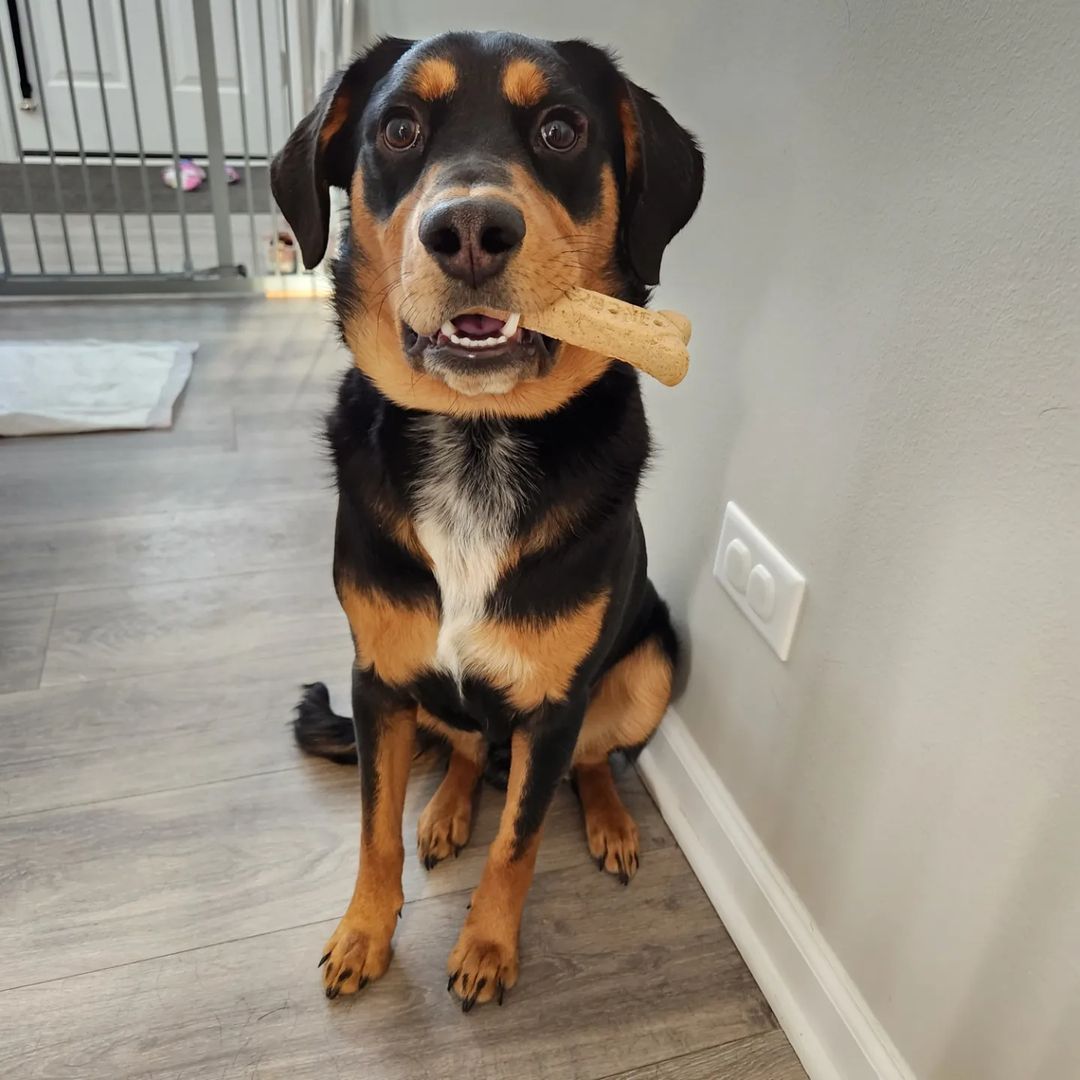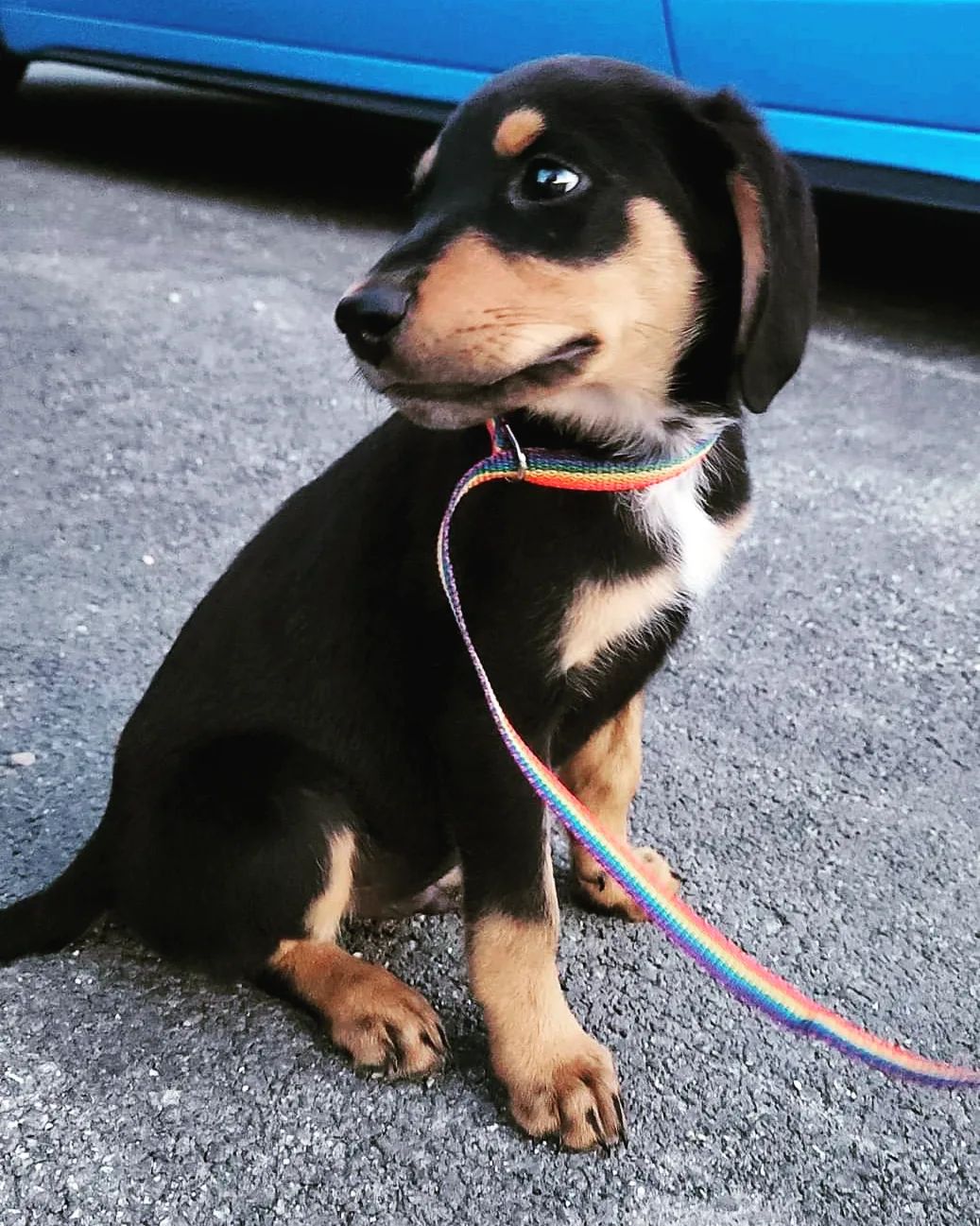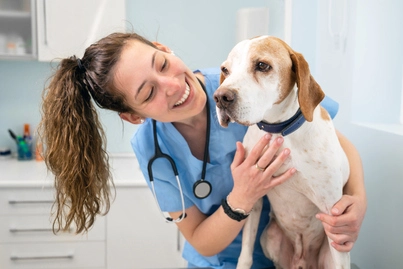The German Shepherd Doberman mix, or Doberman Shepherd, is a large, muscular dog. They’re affectionate, protective, and loyal. These dogs are also high-energy and need lots of exercise each day to stay fit and happy.

In this article, we’ll talk all about this mixed breed, what the puppies look like, how they’ll behave, and more!
What does a Doberman Shepherd Look Like?
The first thing to know about Doberman Shepherds is that they’re big dogs! Just how big depends on which parent breed they take after.
- German Shepherds stand 22-24 inches tall and weigh 50-90 pounds.
- Doberman Pinschers are 24-28 inches tall and weigh 60-100 pounds.
Mixed breeds can take any combination of traits from their parent breeds, which means your Doberman Shepherd may grow to be anywhere from 22-28 inches and weigh 50-100 pounds.
They may have pointed or floppy ears, long snouts, deep chests, and long legs. While German Shepherds have naturally upright ears, Dobermans are born with floppy ears that are often cropped. This is a cosmetic procedure and has no benefit to the dog–only drawbacks.
The same goes for tail docking, which is also typically done with the breed. Both are unethical, and I suggest avoiding any breeder who is willing to hurt their dogs for the sake of profit or appearances.
Puppies can have any coat color or combination accepted under the German Shepherd or Doberman breed standards.
These include:
- Black and rust
- Blue and rust
- Red and rust
- Fawn and rust
- Black
- Black and cream
- Black and red
- Black and silver
- Black and tan
- Blue
- Gray
- Liver
- Sable
- White
- Bi-color
In addition, the coat may be very short or medium-length. Dobermans have a single coat, while German Shepherds have double coats, meaning a mixed breed may or may not have an undercoat.
Grooming a Doberman Shepherd
Speaking of undercoats, they do make a difference when it comes to how your dog sheds and the maintenance their coat requires!
Both parent breeds shed significantly year-round, but a Doberman Shepherd with an undercoat will also have shedding seasons twice a year in which they shed even more than normal. They also need extra grooming at this time.
If your dog has a Doberman Pinscher coat, they’ll need to be brushed around once weekly. It’s a quick job due to their short coat, and it removes shed fur that’ll otherwise wind up around the house.
Brushing your dog’s coat also helps to distribute their natural oils, keeping their fur and skin healthier.
A dog with a German Shepherd coat should be brushed every few days outside of shedding season, and daily during shedding season.
Neither dog needs to be bathed often. If they begin to get smelly or they’ve gotten into something like a muddy puddle, you’ll know it’s time.
Other aspects of grooming to consider are trimming their nails and cleaning their ears monthly, and brushing their teeth daily or as often as is feasible.
Is a Doberman German Shepherd Mix a Good Dog?
One of the most important things to consider when adopting a dog is temperament. Some people will warn you off of this mix because the parent breeds are known for aggression, but I would say that Doberman Shepherds can be great dogs!
The thing to consider is whether they’re the right dog for your lifestyle, and the next few sections will help you to answer that.
First, let’s address the stereotype when it comes to aggression. Both parent breeds are large, strong dogs bred for their protective instincts. It’s important that you can handle your dog on a leash, which is a big task seeing as they can weigh up to 100 pounds!
And, of course, their instinct to protect can go wrong if they try to protect you from the wrong thing or if they’re poorly trained.
You don’t want these dogs to feel anxious or insecure. While this can’t always be avoided, a peaceful household where everyone has respect for one another and your dog goes a long way. So does proper socialization (the process of introducing your dog to new things) at a young age.
Dobermans are actually fairly open to strangers, while German Shepherds can sometimes be more wary.
Both breeds are very affectionate with their families, and a Doberman Shepherd mix might become your shadow, following you around the house. They’ll likely do well with kids, especially those in the family–but remember that no dog should ever be left unattended with a child until you become more comfortable with the dog.
They can be playful and goofy when they’re not busy studiously guarding their families or homes and are typically a joy to live with!
How to Train a Doberman Shepherd
Many problems with these dogs, especially when it comes to aggression, come down to people adopting them for the wrong reasons or using poor training techniques.
The first thing to know is to avoid aversive training methods and tools, such as yelling, hitting, shock collars, leash pops, etc.
Especially avoid any training advice that tells you to dominate your dog, become the “alpha,” or similar. This is called the dominance theory of dog training, and it’s been debunked for a long time.
Not only that, but these techniques are dangerous. They hurt your dog, yes, but also your relationship with your dog. They can cause fearfulness and aggression if your dog feels unsafe and retaliates as a result of your abuse.
Aversive training methods in general, will sometimes show results in the short term but often aren’t as successful long-term. There are also simply better ways to teach–and why would we hurt a dog or make them uncomfortable if we don’t have to?
It’s better to use positive reinforcement, such as rewarding your dog with treats, praise, or play. For unwanted behaviors, you can ignore, redirect, or remove your dog from the situation. For instance, giving a biting puppy, a toy is redirecting. Walking away so they can’t bite you, and they learn that the fun ends when they bite, is ignoring the behavior and removing them from the situation.
Management is often key, which means setting your dog up for success. For instance, don’t leave food out and expect your dog not to eat it–pick it up instead, or put a baby gate up in the kitchen doorway.
How Much Exercise do Doberman Shepherds Need?
These are high-energy, working dogs. If you don’t have hours to spend exercising them each day, please reconsider adoption.
No matter which breed they take after, a Doberman Shepherd mix will need at least one long walk, hike, or run daily. Once you’re home, they’ll likely still want to play and run around the backyard.

If you adopt a puppy under two years old, starting them off slow when it comes to exercise is important. Over-exercising large dogs as puppies can actually harm their joints as they’re still growing.
Lastly, make sure you’re also providing your dog with mental stimulation. These are smart dogs who need their minds occupied with training, games, and toys.
Not providing them with enough exercise or mental stimulation will likely result in your dog misbehaving, as they become anxious and bored, and look for ways to release their pent-up energy. They might become destructive, bark excessively, or misbehave in other ways.
How Long do Doberman Shepherds Live?
German Shepherds, unfortunately, have low life expectancies, living just 7-10 years on average. This is slightly lower than many other breeds of the same size and occurs in large part due to show lines breeding for sloped backs.
This has a negative impact on a dog’s joints and can cause spinal issues such as degenerative myelopathy.
Doberman Pinschers live longer, with a 10-12 year average.
A mixed breed’s lifespan will depend on whether they inherited health problems from either parent breed. For Doberman Shepherds, it could fall anywhere between 7-12 years.
Of course, there’s no predicting how long a particular dog will live. While most will align with the average for their breed(s), poorly-bred dogs might die much sooner (even as puppies). And, some lucky pups will long outlive their expected lifespan.
For instance, the oldest known Doberman Pinscher lived to be 16 years old, and a Turkish German Shepherd mix named Zeynep is 23 years old and might be the oldest dog in the world at the time I’m writing this.
How Much does a Doberman German Shepherd Mix Cost?
When we talk about budgeting for a dog, there are two types of costs. You have your one-time costs, like adoption fees, and your recurring costs, like food.
This mix is rarely bred on purpose, so you’re likely not going to pay any more than a few hundred dollars as an adoption fee. Before adopting, you’ll likely want to purchase a collar, leash, food, water bowls, toys, and grooming supplies like nail clippers and a brush. You might also want a harness and a crate, depending on your preferences.
When adopting a new dog, I also like to stock up on their food and treats. Lastly, you’ll want to bring your dog to the veterinarian as soon as possible after adoption to ensure they’re healthy. This is especially vital before introducing them to other pets in your household.
Connect with a verified veterinarian in minutes. No waiting for appointments or office hours. No high fees. Your pet's health made convenient and worry-free.
When it comes to recurring costs, food will likely be pricey for these big pups! Also, consider yearly vet check-ups, the cost of parasite prevention medication, and replacing any items that wear out over time. For instance, large dogs often go through a lot of toys since they tend to get ripped apart!
Finding Doberman Shepherd Mix Puppies for Sale
It’s hard to find a reputable breeder and harder to find one who sells mixed-breed puppies. Most likely, you’ll find these mutts at a shelter, rescue, or backyard breeder.

Avoid Backyard Breeders
You never want to adopt from backyard breeders–these are people who either don’t know or don’t care how to properly breed dogs. They often won’t test the parent dogs for genetic health conditions, meaning they’re likely passing health problems down to the puppies.
They might not care for their dogs properly, not bring the puppies to the veterinarian, give you poor care advice, and generally aren’t responsible when it comes to breeding, caring for, or selling their dogs.
Reputable breeders ensure their dogs don’t end up in shelters, but backyard breeders are the reason shelters and rescues are so overcrowded, and many dogs, unfortunately, die because of it.
Find a Shelter or Rescue
To find a very specific breed mix, you’ll likely be waiting a long time and might have to travel. You’re likely going to be better off widening your search.
Shelters and many rescues will have dogs of all breeds, but you might want to look into breed-specific rescues as well.
Looking at both German Shepherd and Doberman Pinscher rescue groups will narrow your search to the breeds you want. These groups will often take in mixes as well as purebreds.
Conclusion
In conclusion, the Doberman Shepherd is a mixed breed that can grow to be a large, muscular dog, and they are known for their affectionate, protective, and loyal behavior.
While both parent breeds shed significantly year-round, a Doberman Shepherd with an undercoat will also have shedding seasons twice a year in which they shed even more than normal. They can be great dogs for families as long as they are trained properly and socialized early on.
Overall, the Doberman Shepherd can be a joy to live with as long as they receive proper care and attention.
Frequently Asked Questions
What is a Doberman Shepherd?
A Doberman Shepherd is a mixed breed dog that is a cross between a Doberman Pinscher and a German Shepherd.
What does a Doberman Shepherd look like?
A Doberman Shepherd can be anywhere from 22-28 inches tall and weigh between 50-100 pounds. They may have pointed or floppy ears, long snouts, deep chests, and long legs. They can have any coat color or combination accepted under the German Shepherd or Doberman breed standards.
How should a Doberman Shepherd be groomed?
A Doberman Shepherd’s coat requires regular brushing, with more frequent grooming required during shedding seasons. Their nails should be trimmed, and ears cleaned monthly, while their teeth should be brushed daily.
Is a Doberman Shepherd a good dog?
Doberman Shepherds can make great dogs, but it’s important to consider whether they are the right dog for your lifestyle. Both parent breeds are known for their protective instincts, so proper training and socialization are key to raising a well-behaved dog.
How should you train a Doberman Shepherd?
It’s important to avoid aversive training methods and tools, such as yelling, hitting, shock collars, and leash pops. Positive reinforcement training is a more effective and humane method of training that will result in a better relationship between you and your dog.

